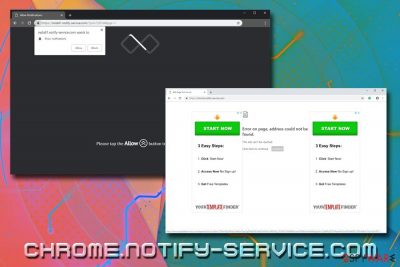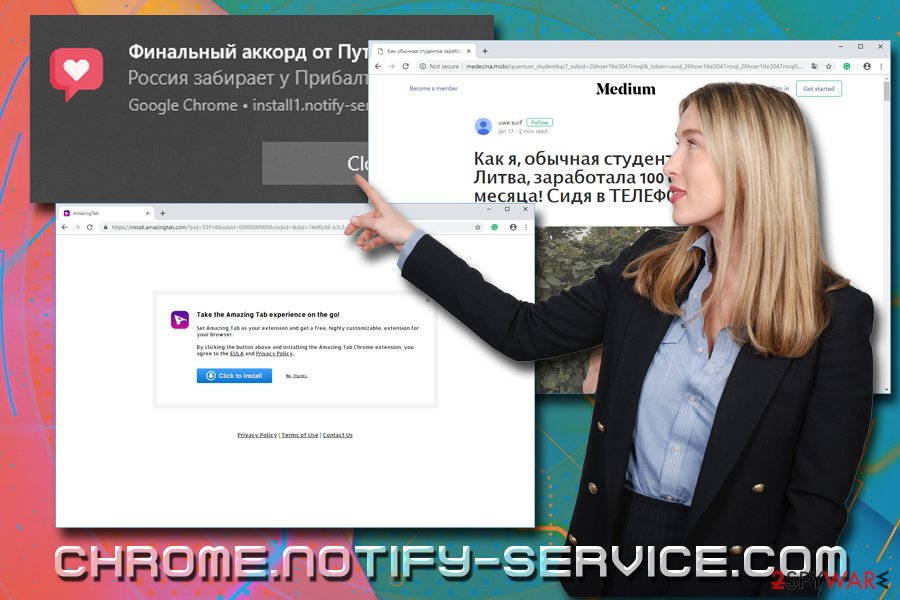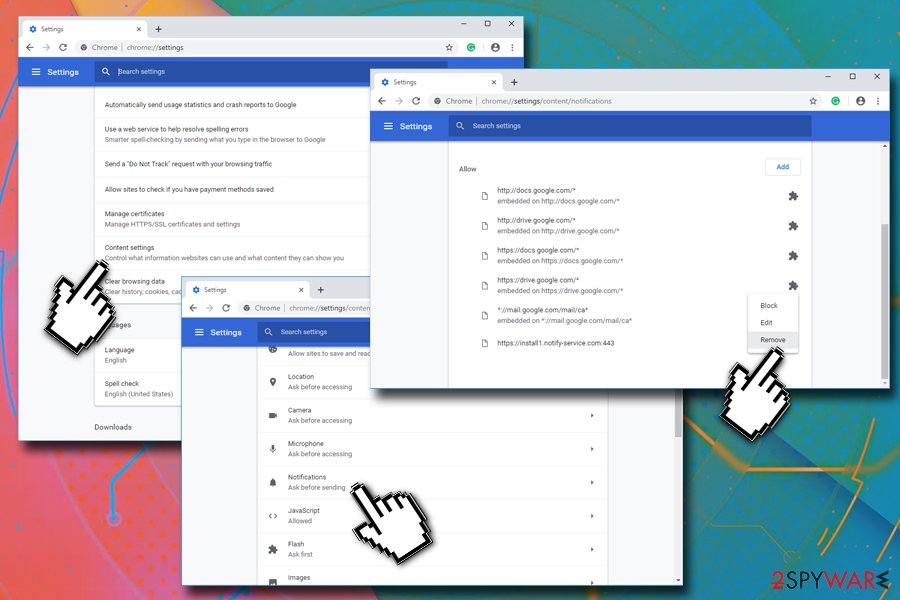Chrome.notify-service.com (Removal Guide) - Free Instructions
Chrome.notify-service.com Removal Guide
What is Chrome.notify-service.com?
Chrome.notify-service.com is a dangerous phishing site that displays unwanted content on Google Chrome or other browsers

Chrome.notify-service.com is a cybersecurity threat that belongs to push notification virus category. The domain, which users mostly visit unintentionally, asks them to allow notifications and, once the permission is granted, starts redirecting to various bogus software download sites. Unfortunately, this behavior can also lead users to vulnerable or hacked domains, where malware can be installed or personal information stolen. Generally, Chrome.notify-service.com is not as harmful as long as visitors leave it immediately. However, problems start when users get redirected to the deceptive site continually – it means that the device is infected with adware[1] application, and until it is deleted, pop-ups, notifications, banners, deals, offers, in-text links, and similar unwanted content will be shown on Google Chrome, Safari, Mozilla Firefox, or MS Edge browsers.
| SUMMARY | |
| Name | Chrome.notify-service.com |
| Type | Adware/Push notification virus |
| Infiltration | Software bundling, malicious adverts, insecure sites |
| Main dangers | Malware infection, personal data leak |
| Symptoms | Redirects to suspicious websites, intrusive advertisement, sponsored links, etc. |
| Elimination | Check out our guide below |
| Optimization | To recover from adware infection, scan your PC with FortectIntego |
There are several aspects of Chrome.notify-service.com that makes it a phishing one. First of all, the domain name – there is no accident that crooks chose such words like “Chrome” and “service,” as it instantly makes users associate it with something trustworthy (as evident, Chrome is the most prominent browser in the world, and bad actors are quick to make use of such popularity, as usual).
Secondly, users are greeted with a fake error message stating the following:
Error on page, address could not be found.
This site can' be reached
Click Here to continue
As soon as the users click ANYWHERE on the page, they are redirected to install1.notify-service.com, which prompts them to Allow notifications to view the contents of the site. This trick has been not only used by the Chrome.notify-service.com virus but also many other alike sites: Rowsebabdo.club, Haphetititletleres.club, Nsmaking.com, and many others.
If users agree to subscribe to notifications, they will be immediately guided to a page that prompts them to download Amazing Tab PUP or other bogus software. Additionally, they will be continuously bugged by pop-ups and redirects to questionable sites, where personal data like banking details can be leaked, or even malware downloaded. To remove Chrome.notify-service.com notifications, you will have to get rid of the entry in your browser settings (we explain how to do that in the last section).
However, if your browser suspiciously redirects you not only to Chrome.notify-service.com site but also to other questionable domains, it means that adware is involved. Ad-supported software seeks monetary benefit by exposing users to commercial sites by using a pay-per-click[2] scheme. Unfortunately, this activity can also compromise users' online safety and computer security.
Therefore, to successfully perform Chrome.notify-service.com removal, you will have to locate and eliminate the adware program. You can either do that manually or rely on security software that can detect PUPs. Finally, we recommend you scan your device with FortectIntego to restore its functions.

Adware and other PUPs should be avoided to bypass security risks
Initially, adware and such-like programs are not considered to be malware (although some PUPs display exceptionally intrusive behavior and modify system settings).[3] However, an ad-supported application can serve as a tunnel to places on the internet that are unsafe, such as tech support scams, phishing, spoofed and similar sites. All these hazards can result in accidental personal information exposure to malicious actors, harmful software installation, as well as money loss. Therefore, do not risk it and make sure you avoid potentially unwanted programs.
Most unwanted applications are installed together with shareware or freeware, and users do not even notice the infiltration. This happens because developers use various tricks to hide optional components within installation wizards, and makes less IT-savvy individuals more prone to such infections.
Therefore, be careful when you install new software from the internet. Choose reputable download sources, make sure you read EULA and Privacy Policy, read through the installation instructions and, most importantly, pick Custom/Advanced installation settings – it will allow you to get rid of PUPs before they get installed.
Get rid of Chrome.notify-service.com pop-ups in an easy way
Chrome.notify-service.com removal instructions depend on whether or not your device is affected by adware. Just to be sure, experts advise[4] to scan your PC with security software, as other infections might be present as well. Alternatively, you can remove Chrome.notify-service.com virus manually as per our instructions below. Beware that adware might be disguised and it sometimes is pretty hard to determine which app the PUP is associated with.
Once you get rid of the potentially unwanted program, you should also reset your browsers – Google Chrome, MS Edge, Mozilla Firefox, Safari, and all the others that are installed on your device. In case security software did not find any infections, and Chrome.notify-service.com notifications are not leaving your screen, perform the following steps to stop pop-ups on Google Chrome:
- Click on Settings and select Advanced;
- Under Privacy and Security, click on Content Settings;
- Go to Notifications;
- Locate Chrome.notify-service.com or install1.notify-service.com and remove links from the list.

Mozilla Firefox:
- Click on Settings and select Options;
- Go to Privacy & Security;
- Find Permissions and choose Settings;
- Locate Chrome.notify-service.com or install1.notify-service.com, click on drop-down button and select Block.
Safari:
- Click on Safari and select Preferences;
- Go to Notifications;
- Locate Chrome.notify-service.com or install1.notify-service.com and select Deny;
Internet Explorer:
- Select Settings and then Internet Options;
- Under Privacy tab, choose Settings;
- Find Chrome.notify-service.com or install1.notify-service.com and get rid of it.
Android (Chrome):
- Click on the Menu and select Site settings;
- Pick Notifications;
- You will find a list of Blocked and Allowed notifications;
- Pick Chrome.notify-service.com, install1.notify-service.com, and any other unknown sites and tap on Clear & Reset.
You may remove virus damage with a help of FortectIntego. SpyHunter 5Combo Cleaner and Malwarebytes are recommended to detect potentially unwanted programs and viruses with all their files and registry entries that are related to them.
Getting rid of Chrome.notify-service.com. Follow these steps
Uninstall from Windows
To remove Chrome.notify-service.com pop-ups and other intrusive behavior, perform these actions:
Instructions for Windows 10/8 machines:
- Enter Control Panel into Windows search box and hit Enter or click on the search result.
- Under Programs, select Uninstall a program.

- From the list, find the entry of the suspicious program.
- Right-click on the application and select Uninstall.
- If User Account Control shows up, click Yes.
- Wait till uninstallation process is complete and click OK.

If you are Windows 7/XP user, proceed with the following instructions:
- Click on Windows Start > Control Panel located on the right pane (if you are Windows XP user, click on Add/Remove Programs).
- In Control Panel, select Programs > Uninstall a program.

- Pick the unwanted application by clicking on it once.
- At the top, click Uninstall/Change.
- In the confirmation prompt, pick Yes.
- Click OK once the removal process is finished.
Delete from macOS
Remove items from Applications folder:
- From the menu bar, select Go > Applications.
- In the Applications folder, look for all related entries.
- Click on the app and drag it to Trash (or right-click and pick Move to Trash)

To fully remove an unwanted app, you need to access Application Support, LaunchAgents, and LaunchDaemons folders and delete relevant files:
- Select Go > Go to Folder.
- Enter /Library/Application Support and click Go or press Enter.
- In the Application Support folder, look for any dubious entries and then delete them.
- Now enter /Library/LaunchAgents and /Library/LaunchDaemons folders the same way and terminate all the related .plist files.

Remove from Microsoft Edge
Delete unwanted extensions from MS Edge:
- Select Menu (three horizontal dots at the top-right of the browser window) and pick Extensions.
- From the list, pick the extension and click on the Gear icon.
- Click on Uninstall at the bottom.

Clear cookies and other browser data:
- Click on the Menu (three horizontal dots at the top-right of the browser window) and select Privacy & security.
- Under Clear browsing data, pick Choose what to clear.
- Select everything (apart from passwords, although you might want to include Media licenses as well, if applicable) and click on Clear.

Restore new tab and homepage settings:
- Click the menu icon and choose Settings.
- Then find On startup section.
- Click Disable if you found any suspicious domain.
Reset MS Edge if the above steps did not work:
- Press on Ctrl + Shift + Esc to open Task Manager.
- Click on More details arrow at the bottom of the window.
- Select Details tab.
- Now scroll down and locate every entry with Microsoft Edge name in it. Right-click on each of them and select End Task to stop MS Edge from running.

If this solution failed to help you, you need to use an advanced Edge reset method. Note that you need to backup your data before proceeding.
- Find the following folder on your computer: C:\\Users\\%username%\\AppData\\Local\\Packages\\Microsoft.MicrosoftEdge_8wekyb3d8bbwe.
- Press Ctrl + A on your keyboard to select all folders.
- Right-click on them and pick Delete

- Now right-click on the Start button and pick Windows PowerShell (Admin).
- When the new window opens, copy and paste the following command, and then press Enter:
Get-AppXPackage -AllUsers -Name Microsoft.MicrosoftEdge | Foreach {Add-AppxPackage -DisableDevelopmentMode -Register “$($_.InstallLocation)\\AppXManifest.xml” -Verbose

Instructions for Chromium-based Edge
Delete extensions from MS Edge (Chromium):
- Open Edge and click select Settings > Extensions.
- Delete unwanted extensions by clicking Remove.

Clear cache and site data:
- Click on Menu and go to Settings.
- Select Privacy, search and services.
- Under Clear browsing data, pick Choose what to clear.
- Under Time range, pick All time.
- Select Clear now.

Reset Chromium-based MS Edge:
- Click on Menu and select Settings.
- On the left side, pick Reset settings.
- Select Restore settings to their default values.
- Confirm with Reset.

Remove from Mozilla Firefox (FF)
If Mozilla Firefox is displaying multiple ads, you should reset it in the following way:
Remove dangerous extensions:
- Open Mozilla Firefox browser and click on the Menu (three horizontal lines at the top-right of the window).
- Select Add-ons.
- In here, select unwanted plugin and click Remove.

Reset the homepage:
- Click three horizontal lines at the top right corner to open the menu.
- Choose Options.
- Under Home options, enter your preferred site that will open every time you newly open the Mozilla Firefox.
Clear cookies and site data:
- Click Menu and pick Settings.
- Go to Privacy & Security section.
- Scroll down to locate Cookies and Site Data.
- Click on Clear Data…
- Select Cookies and Site Data, as well as Cached Web Content and press Clear.

Reset Mozilla Firefox
If clearing the browser as explained above did not help, reset Mozilla Firefox:
- Open Mozilla Firefox browser and click the Menu.
- Go to Help and then choose Troubleshooting Information.

- Under Give Firefox a tune up section, click on Refresh Firefox…
- Once the pop-up shows up, confirm the action by pressing on Refresh Firefox.

Remove from Google Chrome
As soon as you eliminate the PUP, reset Google Chrome using this guide:
Delete malicious extensions from Google Chrome:
- Open Google Chrome, click on the Menu (three vertical dots at the top-right corner) and select More tools > Extensions.
- In the newly opened window, you will see all the installed extensions. Uninstall all the suspicious plugins that might be related to the unwanted program by clicking Remove.

Clear cache and web data from Chrome:
- Click on Menu and pick Settings.
- Under Privacy and security, select Clear browsing data.
- Select Browsing history, Cookies and other site data, as well as Cached images and files.
- Click Clear data.

Change your homepage:
- Click menu and choose Settings.
- Look for a suspicious site in the On startup section.
- Click on Open a specific or set of pages and click on three dots to find the Remove option.
Reset Google Chrome:
If the previous methods did not help you, reset Google Chrome to eliminate all the unwanted components:
- Click on Menu and select Settings.
- In the Settings, scroll down and click Advanced.
- Scroll down and locate Reset and clean up section.
- Now click Restore settings to their original defaults.
- Confirm with Reset settings.

Delete from Safari
Remove unwanted extensions from Safari:
- Click Safari > Preferences…
- In the new window, pick Extensions.
- Select the unwanted extension and select Uninstall.

Clear cookies and other website data from Safari:
- Click Safari > Clear History…
- From the drop-down menu under Clear, pick all history.
- Confirm with Clear History.

Reset Safari if the above-mentioned steps did not help you:
- Click Safari > Preferences…
- Go to Advanced tab.
- Tick the Show Develop menu in menu bar.
- From the menu bar, click Develop, and then select Empty Caches.

After uninstalling this potentially unwanted program (PUP) and fixing each of your web browsers, we recommend you to scan your PC system with a reputable anti-spyware. This will help you to get rid of Chrome.notify-service.com registry traces and will also identify related parasites or possible malware infections on your computer. For that you can use our top-rated malware remover: FortectIntego, SpyHunter 5Combo Cleaner or Malwarebytes.
How to prevent from getting adware
Choose a proper web browser and improve your safety with a VPN tool
Online spying has got momentum in recent years and people are getting more and more interested in how to protect their privacy online. One of the basic means to add a layer of security – choose the most private and secure web browser. Although web browsers can't grant full privacy protection and security, some of them are much better at sandboxing, HTTPS upgrading, active content blocking, tracking blocking, phishing protection, and similar privacy-oriented features. However, if you want true anonymity, we suggest you employ a powerful Private Internet Access VPN – it can encrypt all the traffic that comes and goes out of your computer, preventing tracking completely.
Lost your files? Use data recovery software
While some files located on any computer are replaceable or useless, others can be extremely valuable. Family photos, work documents, school projects – these are types of files that we don't want to lose. Unfortunately, there are many ways how unexpected data loss can occur: power cuts, Blue Screen of Death errors, hardware failures, crypto-malware attack, or even accidental deletion.
To ensure that all the files remain intact, you should prepare regular data backups. You can choose cloud-based or physical copies you could restore from later in case of a disaster. If your backups were lost as well or you never bothered to prepare any, Data Recovery Pro can be your only hope to retrieve your invaluable files.
- ^ Adware. TechTerms. The Tech Terms Computer Dictionary.
- ^ Pay-Per-Click Advertising: What Is PPC & How Does It Work?. WordStream. Online Advertising Made Easy.
- ^ Hack brief: dangerous "Fireball" adware infects a quarter billion PCs. Wired. American magazine that focuses on how emerging technologies affect culture, the economy, and politics.
- ^ Virusi. Virusi. Cybersecurity news and articles.























